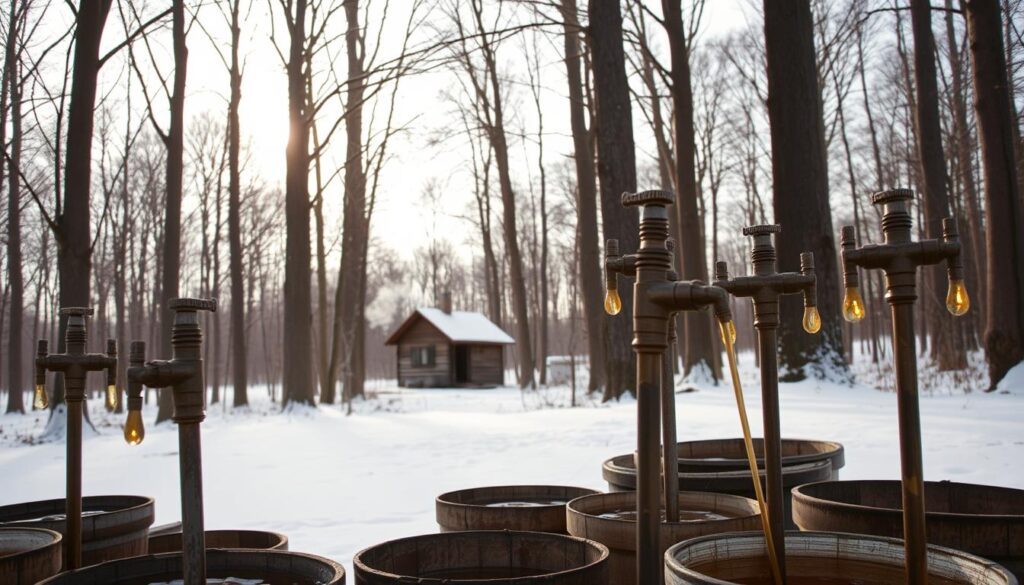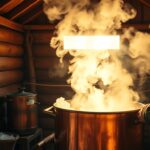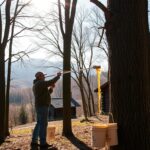Imagine turning a simple tree into liquid gold. Maple syrup production connects you to nature’s sweetness. Every spring, sugarmakers tap into maple syrup sap, making a treat loved by many.
Maple syrup making is more than cooking—it’s a family tradition. It involves choosing the right trees, using special techniques, and knowing nature’s cycles. Whether you’re interested in food or want to make syrup at home, it’s a rewarding journey.
Start by learning about maple tree selection, timing, and how to extract sap. Sugar maples are best for syrup. Both pros and hobbyists use certain methods to collect sap without harming the trees.
The magic of maple syrup comes from the tree’s system. In spring, maple trees turn starches into sugar, making the sap sweet. Each tap can give 10 to 20 gallons of sap, making about one quart of syrup.
This guide will show you how to make maple syrup. You’ll learn to identify trees, tap them, and boil the sap. You’ll discover how to turn raw sap into a delicious syrup that enhances many dishes.
Understanding Maple Syrup Sap: Nature’s Sweet Gift
Maple tree sap is a natural wonder that turns into a tasty treat. It starts deep inside the maple tree, where nature makes a sweet liquid with special qualities.
The syrup-making journey begins with the tree’s amazing sap production. Maple trees make this liquid to survive the cold winter. They store nutrients and energy in it.
Chemical Composition of Maple Sap
Maple sap is mostly water with a bit of sugar. It usually has:
- 97-99% water
- 1-3% sugar (mainly sucrose)
- Small amounts of minerals like calcium, potassium, and magnesium
Why Maple Trees Produce Sap
Trees make sap to survive. In winter, sugars in the sap prevent the tree from freezing. When spring comes, these sugars help the tree grow.
“Maple sap is nature’s ingenious method of tree preservation and renewal.” – Forest Ecology Research Institute
Different Types of Maple Trees for Tapping
Not all maple trees give the same amount of sap. Some are better for making syrup:
- Sugar Maple: Has the most sugar, perfect for syrup
- Red Maple: Produces good sap, but with less sugar
- Black Maple: Similar to sugar maple
Each maple tree type adds something special to syrup-making. This gives syrup makers many choices for their work.
Essential Tools and Equipment for Maple Sap Collection
Collecting maple sap needs special tools and equipment. These help get and keep the sap’s sweetness. Sugarmakers pick their gear carefully for a smooth process.
- Tapping Tools
- Collection Containers
- Storage Equipment
- Processing Gear
Tapping tools are vital for sap collection. You’ll need:
- Drill with maple tapping bits
- Food-grade spiles (taps)
- Hammer or mallet for tapping
Different methods need different tools. Small producers might use buckets, while big ones use tubing networks.
| Equipment Type | Small-Scale Needs | Large-Scale Needs |
|---|---|---|
| Collection System | Hanging buckets | Vacuum tube networks |
| Storage | 5-gallon food-grade containers | Large stainless steel tanks |
| Filtering | Mesh strainers | Commercial filtration systems |
Pro tip: Use only food-grade materials to avoid contamination. Stainless steel and clean plastic are best for sap quality.
Good equipment leads to better sap collection and syrup quality. Choose the right tools based on your scale and goals.
When Is the Perfect Time to Tap Maple Trees
Tapping maple trees is an art that needs the right timing and weather. The sugaring season is a magical time when sap flows freely. Knowing when to tap can make a big difference in your harvest.
Maple syrup making is all about temperature and tree biology. Trees are ready to tap when certain seasonal conditions meet.
Weather Conditions for Optimal Sap Flow
The best time to tap maple trees is when temperatures swing a lot. Sugarmakers look for days that are just above freezing and nights that are below. This pressure makes sap flow.
- Daytime temperatures: 40-45°F
- Nighttime temperatures: 20-25°F
- Consistent freeze-thaw cycles
Seasonal Timing Guidelines
The sugaring season is from late winter to early spring, usually in February and March. But, the exact timing can vary by region.
| Region | Typical Tapping Period | Average Duration |
|---|---|---|
| Northeast United States | Late February – Early April | 4-6 weeks |
| Midwest | March – Mid-April | 3-5 weeks |
| Southern Canada | February – Late March | 4-6 weeks |
Signs Your Trees Are Ready
Experienced sugarmakers know when trees are ready to tap. Look for swelling buds, emerging leaves, and bark changes. These signs mean the tree is ready to produce sap.
- Bark color changes
- Buds beginning to swell
- First signs of leaf development
- Increased tree moisture
Timing is everything when tapping maple trees. It’s a craft that requires patience and attention to nature’s signs. This way, you can catch the sweet sap during the sugaring season.
Identifying the Right Maple Trees for Tapping
Choosing the right maple trees for tapping is key to good sap production. Not every maple tree is good for sap collection. Sugarmakers need to pick trees carefully for the best sap yield.
When picking trees for tapping, look for these important traits:
- Minimum tree diameter of 10 inches at chest height
- Trees at least 40 years old
- Strong, healthy trunk without significant damage
- Broad crown with extensive branch spread
- Exposure to adequate sunlight
The best maple species for tapping are:
- Sugar Maple (highest sugar content)
- Red Maple
- Black Maple
- Silver Maple
Professional sugarmakers suggest marking trees in summer when leaves are out. This makes it easier to identify and plan before tapping starts. Look for trees with smooth bark, little scarring, and strong growth.
A healthy maple tree can produce sap for decades when properly managed and tapped.
Knowing about tree health and traits helps with long-term sap collection and keeps trees healthy.
Step-by-Step Guide to Tapping Maple Trees
Tapping maple trees is an art that needs precision and care. It turns a simple woodland activity into a tasty culinary journey. Sugarmakers have honed these skills over generations, ensuring trees are not harmed while getting lots of sap.
Success in tapping maple trees comes from careful preparation and technique. Choosing the right maple tree is key to the sap collection process.
Proper Drilling Techniques
Here are important tips for drilling tapholes:
- Select a healthy tree at least 10 inches in diameter
- Choose a sunny side of the tree with minimal bark damage
- Drill at a slight upward angle, approximately 2-3 inches deep
- Use a clean, sharp drill bit between 7/16 and 5/16 inches
Spout Installation Methods
Installing spouts needs gentle precision during maple sap collection. Clean and sanitize all equipment before use to avoid bacterial contamination.
- Insert spout immediately after drilling
- Tap gently with a hammer until secure
- Ensure a tight seal without splitting the bark
- Check spout stability before hanging collection container
Collection System Setup
Decide between traditional bucket systems or modern tubing networks based on your needs and maple grove characteristics.
Professional sugarmakers recommend checking your taps and collection systems regularly to maintain optimal sap flow.
Collecting and Storing Raw Maple Sap

Harvesting maple sap needs careful attention and the right techniques. The syrup-making journey starts with collecting sap from maple trees in the best sugaring season. It’s important to collect and store the sap well to get the best syrup quality.
Several key factors are important for successful sap collection:
- Timing of collection
- Temperature management
- Storage conditions
- Quick processing
Maple sap is very perishable and needs quick care after it’s collected. The best time to collect sap is usually just a few weeks in late winter and early spring. Collectors must be ready to gather sap often, sometimes every day, based on how fast it flows.
| Collection Factor | Recommended Practice |
|---|---|
| Collection Frequency | Every 24-48 hours |
| Storage Temperature | Below 38°F (3°C) |
| Maximum Storage Time | 7 days before processing |
Professional sugarmakers use special containers to keep sap quality high. Stainless steel buckets or food-grade plastic containers are best for keeping raw maple sap fresh. Keeping the sap cold stops bacteria from growing and keeps its natural sweetness.
Clean equipment is also very important in making maple syrup. All tools must be cleaned well between uses to avoid contamination. This helps keep the sap’s pure taste.
Converting Sap to Syrup: The Boiling Process
The maple syrup production process turns raw sap into golden syrup. This step needs careful attention and specific temperature control. It’s all about making the perfect maple syrup.
Sugarmakers watch closely as sap turns into syrup. The boiling process makes the sap’s natural sugars more concentrated. It turns watery sap into thick, rich syrup.
Temperature Control Guidelines
Keeping the right temperature is key in making maple syrup. The ideal boiling point is between 219-221 degrees Fahrenheit. Sugarmakers use special equipment to keep the heat steady:
- Evaporator pans with precise temperature controls
- Digital thermometers for accurate readings
- Steam-powered heating systems
Monitoring Sugar Content
It’s important to track the syrup’s sugar content for quality. Sugarmakers use special tools to measure sugar density:
| Measurement Tool | Accuracy Level | Usage |
|---|---|---|
| Hydrometer | High | Measures sugar density in liquid |
| Refractometer | Very High | Precise sugar content measurement |
Filtering Methods
The last step is filtering to remove minerals and ensure clarity. Professional sugarmakers use multi-stage filtering techniques. This keeps the syrup’s flavor rich while removing impurities.
- Hot filtering methods
- Specialized paper filters
- Gravity-based filtering systems
Each step in making maple syrup needs patience, skill, and attention. It turns simple tree sap into a delicious culinary treasure.
Common Mistakes to Avoid in Maple Syrup Production
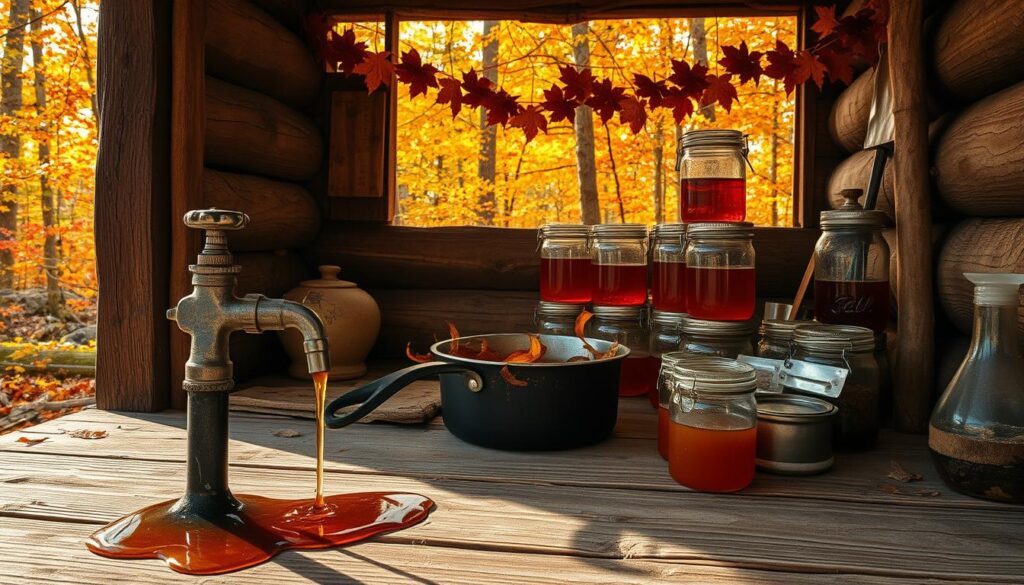
Maple syrup making needs precision and careful attention. Novice sugarmakers often face challenges that can affect their syrup’s quality. Knowing these common mistakes can help ensure a good maple syrup harvest.
One big error is improper tree tapping. Novices might:
- Overtap a single tree, causing long-term damage to its health
- Use incorrect drilling techniques that harm the tree’s bark
- Tap trees that are too young or too small
Sap collection and storage also have their issues. Fresh sap can quickly spoil if not handled correctly. Sugarmakers must be careful about:
- Keeping collection containers clean
- Storing sap at proper temperatures
- Processing sap quickly to prevent bacterial growth
The boiling process is the most delicate stage. Mistakes include:
- Inconsistent heat management
- Failing to monitor sugar content accurately
- Improper filtering techniques
Success in maple syrup production requires patience, knowledge, and attention to detail. By avoiding these common mistakes, sugarmakers can make high-quality syrup and protect their maple trees.
Understanding Maple Syrup Grades and Quality
Maple syrup grades show a world of flavor, color, and quality. They reflect the skill of syrup making. Sugarmakers classify their syrup to help people know what they’re getting.
Producers use a standard grading system. This helps buyers pick the right syrup for their recipes. Grades are based on color and flavor.
Color Classifications
Maple syrup grades are mainly based on how they look. They range from light to dark:
- Golden Color: Delicate, mild flavor with subtle sweetness
- Amber Color: Rich, more pronounced maple taste
- Dark Color: Robust, intense maple flavor
- Very Dark Color: Strong, distinctive maple character
Taste Profiles
Every maple syrup grade has its own taste. Lighter syrups are milder, while darker ones are more intense.
“The color of maple syrup tells a story of its production and flavor intensity” – Maple Syrup Experts Association
Grading Standards
The USDA sets official maple syrup grades. They look at light transmission and flavor. These standards ensure quality and consistency for buyers.
Sugarmakers are proud of their work. They carefully watch the making process. This way, they create a top-notch syrup that shows maple’s natural sweetness.
Sustainable Tapping Practices for Tree Health
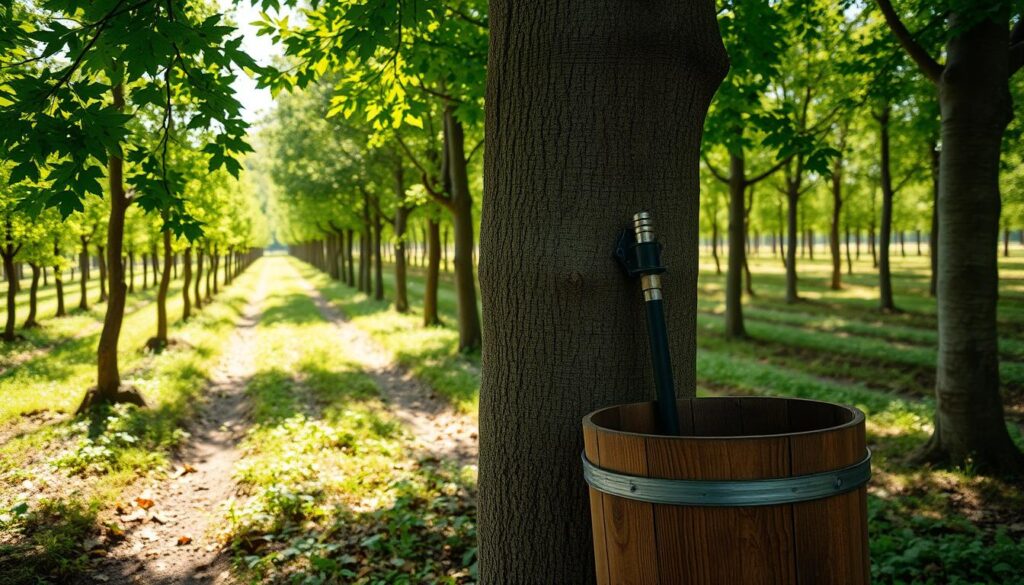
Tapping maple trees needs careful thought to keep these trees healthy for the future. Good practices help maple trees keep producing sap for years. This way, we avoid harming the trees.
To tap maple trees right, you must know about the tree’s biology and use smart methods. The size of the tree is key. Big maple trees, at least 10 inches wide, can handle tapping well. But, smaller trees should not be tapped.
- Select healthy trees with robust trunk diameters
- Rotate tapping locations to prevent tree stress
- Limit the number of tapholes per tree
- Use proper drilling techniques
Where you place the tapholes is very important for the tree’s health. Sugarmakers suggest:
- Drill holes at least 2 inches from where you tapped before
- Avoid tapping near damaged or scarred areas
- Keep the depth of the holes between 1.5 to 2 inches
Watching how the tree reacts is key for making maple syrup in a green way. If a tree looks stressed, like its sap flow is down or its bark is changing color, it’s a sign. Experts keep an eye on these signs to make sure they’re not hurting the tree.
Sustainable tapping is about balancing human needs with forest ecosystem preservation.
By using careful and scientific ways to tap maple trees, we can make yummy maple syrup. And we can keep these amazing trees healthy too.
Storage and Preservation of Homemade Maple Syrup
Storing maple syrup right is key to keeping its quality and taste. Knowing how to preserve it helps sugarmakers keep their syrup fresh longer.
Choosing the Right Containers
Finding the right containers is important in maple syrup making. The top choices are:
- Glass bottles with tight-sealing lids
- Food-grade plastic containers
- Stainless steel containers with secure closures
Temperature Requirements for Preservation
Temperature is key to keeping maple syrup good. Ideal storage conditions are:
- Refrigeration for opened containers (40-45°F)
- Cool, dark pantry for unopened syrup (50-60°F)
- Avoid direct sunlight and heat sources
Shelf Life Guidelines
How long maple syrup lasts depends on how you store it. Unopened syrup can last up to two years. Once opened, keep it in the fridge and use within six months for the best taste.
Pro tip: Always check for signs of mold or fermentation before consuming stored maple syrup.
Troubleshooting Common Maple Syrup Problems
Maple syrup making can face many challenges. These can affect the syrup’s quality. Quick action is key to keeping syrup standards high.
Maple syrup makers often deal with specific issues. Knowing these problems helps control quality and get better results.
- Cloudy Syrup: Often caused by sediment or mineral buildup
- Off-Flavors: Result from bacterial contamination or improper collection
- Crystallization: Occurs due to high sugar concentration
- Mold Growth: Happens with improper storage conditions
Each maple syrup problem needs a unique solution. The first step is to find the cause and then fix it.
| Problem | Potential Cause | Solution |
|---|---|---|
| Cloudy Syrup | Mineral deposits | Use proper filtration techniques |
| Off-Flavors | Bacterial contamination | Maintain clean collection equipment |
| Crystallization | High sugar concentration | Control boiling temperature precisely |
| Mold Growth | Improper storage | Store in sealed, refrigerated containers |
Preventing problems is key in maple syrup making. Sugarmakers should clean equipment often, watch collection conditions, and follow strict hygiene. This helps avoid many issues.
“Clean equipment and precise techniques are the foundation of exceptional maple syrup production.” – Professional Sugarmaker
Success in maple syrup making comes from patience, detail, and a focus on quality at every step.
Economic Benefits of Making Your Own Maple Syrup
Maple syrup is more than just a sweetener. It can turn a hobby into a money-maker. The cost of starting up might seem high, but it pays off over time.
Here are the costs for starting:
- Tapping equipment: $100-$300
- Large boiling pan: $150-$500
- Collection buckets: $50-$150
- Storage containers: $30-$100
A mature maple tree can give 10-20 gallons of sap each season. This means about 1-2 quarts of syrup. Farmers markets sell this syrup for $15-$25 per quart, making it a good way to earn money.
But there’s more to it than just money:
- Educational experience for families
- Connection with traditional farming
- Understanding how food is made naturally
- A sustainable activity at home
Small producers can sell syrup at local markets, online, or directly to people. Some even make maple candies or infused syrups, turning their hobby into a business.
“Maple syrup production isn’t just about making syrup—it’s about creating a meaningful connection with nature and community.” – Local Sugarmaker
Annual earnings from syrup can be $500 to $3,000. It depends on how many trees you tap and how much syrup you sell. Good marketing and quality syrup can make it a profitable side job.
Conclusion
Making maple syrup is more than cooking—it’s a link to nature and American traditions. It starts with knowing maple trees and ends with collecting sap. This journey mixes science, skill, and patience.
Creating maple syrup needs hard work and focus. Every step, from picking trees to boiling sap, requires care. It’s important to tap trees in a way that keeps them healthy for future harvests.
If you love making food from scratch, making maple syrup is for you. It’s about turning sap into a tasty syrup. Learning how to control temperature and understand syrup grades can make your first batch special.
Whether you’re new or experienced, maple syrup is a fascinating topic. It teaches us about farming traditions. By making maple syrup, you create something delicious and join a long-standing cultural tradition.

